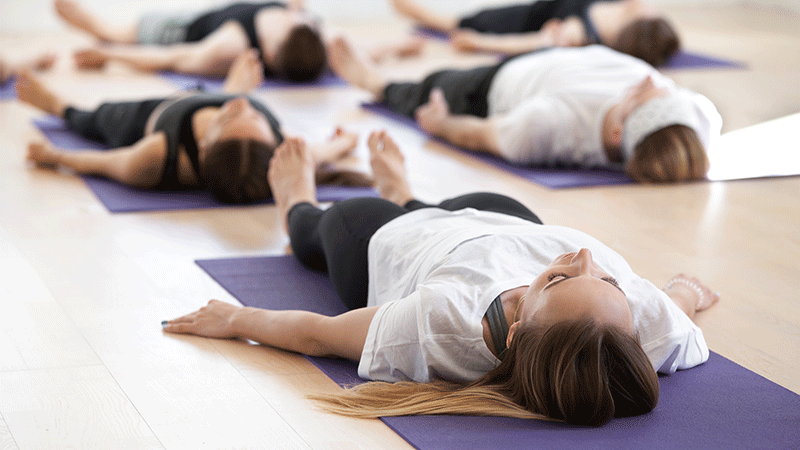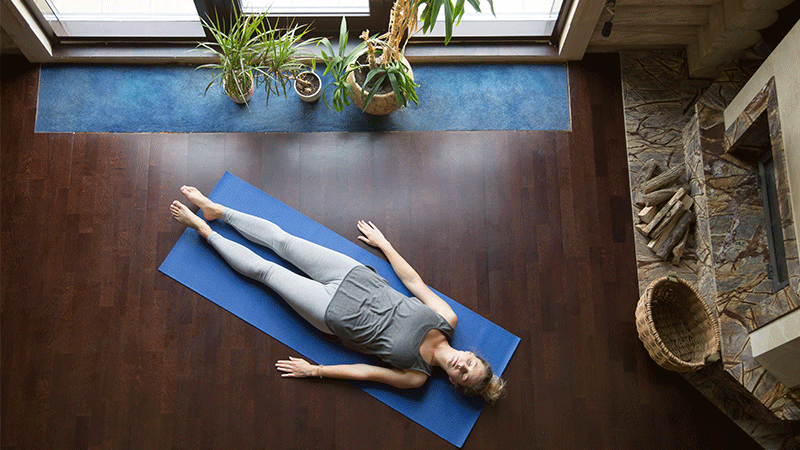Yoga nidra is growing in popularity, and it’s easy to see why. This calming, relaxing, and gentle form of yoga has a lot of potential to help overcome insomnia, anxiety, and many more health problems. If sweaty and fast-paced yoga isn’t your style, you might be in luck. This guide covers everything you need to know about how to do yoga nidra. Let’s get started!
Jump to:
Introduction to Yoga Nidra
Yoga is so much more than just rolling out your mat and stretching. It is an ancient philosophy, way of life, and spiritual practice that focuses on the mind as much as the body.
There are many different types of yoga, all with distinct styles. You might be familiar with hatha yoga which focuses on positions, posture, and breathing techniques. Ashtanga yoga is also very popular as a quick and fiery workout, as well as hot yoga, which is guaranteed to make you sweat!
The above yoga styles (plus many more) focus on physical movement and help you connect to your body. If you think yoga nidra is in the same category, think again…
What is Yoga Nidra?
Yoga nidra, or yoga sleep, is actually a state of consciousness rather than a practice. Rather than working through hundreds of different asanas (yoga poses), the only pose required is laying down!
This practice looks more like meditation than your typical yoga class, but don’t be fooled. Yoga nidra is a highly effective form of yoga that has been practiced for centuries.
The aim of this powerful relaxation technique is to drift into a special place - somewhere between sleep and alertness - where you can allow your mind and body to receive deep rest and restoration.
This is achieved through a very specific form of guidance from your yoga nidra teacher. As you listen to their instructions, you will increase feelings of calm, relaxation, and deep rest.
A typical yoga nidra class can last anywhere from 20 to 60 minutes, and will leave you feeling refreshed on so many levels. Yoga teachers use various yoga nidra scripts depending on the desired effect.

Benefits of Yoga Nidra
There are so many benefits of a regular yoga nidra practice, but here are the most common that you can expect to experience after one class.
1. Reduced Anxiety
Yoga nidra is excellent for reducing mental stress, and therefore reducing anxiety. This study demonstrated that yoga nidra was a highly effective practice for reducing both mental and physical symptoms of anxiety.
Entering a deep state of relaxation allows the mind to switch off from everyday struggles. The calming guidance of the yoga nidra teacher allows you to arrive fully in the moment, so you’ll leave the class feeling refreshed and grounded.
2. Better Sleep
Insomnia and other sleep disturbances are on the rise as we struggle more than ever to switch off. Yoga nidra is greatly beneficial in improving sleep quality as each time you practice yoga nidra, you are teaching your body to relax and unwind. The more you trigger the relaxation response in your body, the easier it is to access each time.
Yoga nidra is also an excellent alternative to taking a nap if you haven’t slept well the night before. Just 30 minutes of yoga nidra can feel like a few hours of deep sleep, so it’s a great way to restore your energy levels if you need to.
3. Relaxing the Nervous System
Yoga nidra works by tapping into your autonomic nervous system. This is the part of the nervous system responsible for resting, recovering, and relaxing. As your heart beat slows and your muscles relax, your body finally has the opportunity to deeply rest and balance itself.
This is essential for managing stress. If you lead a busy life and struggle to switch off, yoga nidra can be a fantastic wellness practice that can offset the effects of leading a busy life.
4. A Deeper Connection to Self
All forms of yoga are powerful self-awareness practices, but yoga nidra is arguably the most effective in cultivating a deeper connection to yourself.
As you switch off from external distractions and follow the guidance of a yoga nidra teacher, you become aware of your body and mind on a deeper level than ever before. Taking the time to connect with yourself in this way is hugely beneficial for personal and spiritual growth.
Who can practice Yoga Nidra?
Almost everyone can practice yoga nidra! It is one of the most accessible forms of yoga since it only involves one pose, which is laying down. All you need is a mat or blanket, cushions, and anything else that helps you feel comfortable.
Although anyone can practice yoga nidra, it is extremely beneficial for those who struggle to let go and relax. This practice is especially powerful for those experiencing stress or tension.
If you struggle to meditate, yoga nidra is also an excellent option for you. The guidance of a yoga nidra session plus the fact that you are laying down means you don’t have to struggle with your thoughts. Say goodbye to the monkey mind!
The Structure of a Yoga Nidra Class
Each teacher has their own way of practicing yoga nidra. That being said, you can expect the following format in each class:
Get into a Comfortable Resting Position
The first, and most important step, is to take as much time as you need to get comfortable. Use as many blankets, cushions, and any other props you need to make sure you feel supported. If you attend an in-person class, these are usually provided.
It is often helpful to place a pillow underneath the head and also the knees to encourage the spine to relax. Some people also enjoy using an eye mask to relax further, or a heated bean bag is also effective.
Make as many micro-adjustments as you need in order to fully relax. If you don’t do this, the rest of the session won’t be effective. This is because you will focus on discomfort rather than switching off.
Listen to the Guidance of the Yoga Nidra Teacher
The teacher will begin guiding you through a very specific set of instructions. This usually begins with gentle breathing followed by a detailed body scan.
You don’t have to think much here. Yoga nidra teachers are highly trained in guiding participants through the different stages of the practice, so it works best if you trust them and let yourself be guided.
Yoga nidra is an ancient form of yoga that has been practiced for years. Trust the process, and allow yourself to fully relax.
Arrive in a State of Deep Relaxation
Here is the best part! As the class progresses, you’ll notice yourself drifting into a blissful state of deep relaxation. Enjoy every minute. Soak up the feelings of calm and peace as your body and mind restore themselves.
If you fall asleep, don’t worry! It’s completely normal. In fact, it is to be expected, especially if you are a beginner. Your subconscious is always listening, so you will naturally pick up on the prompts when it’s time to end the class.
Bring Awareness Back to the Body
Your yoga nidra teacher will gently guide you from a state of deep relaxation to awareness. Invite small movements back into your body, such as wiggling the fingers and toes, and gently blinking your eyes open.
You don’t need to rush this part. Take as much time as you need to become alert. It is often helpful to stretch and yawn to encourage arriving back into the present moment.

Common Challenges and Tips for Overcoming Them
Yoga nidra is a wonderful practice, but you might experience the following challenges during a class. Don’t let these deter you. As you develop a regular yoga nidra practice, challenges tend to melt away as you experience more benefits.
1. Struggling to switch off
Struggling to quiet the mind is the biggest challenge you’re likely to face. You might notice racing thoughts, feeling distracted, or a lack of focus during class. You might even feel frustrated or irritable as you struggle to relax.
Don’t let your resistance to yoga nidra deter you from practicing it. In fact, this is probably a sign that yoga nidra is the perfect practice for you! Be persistent, and trust that the mental chatter will lessen the more you practice relaxing.
Start with 20 minute yoga nidra sessions before building up to longer classes. Be patient with yourself as you develop your awareness and teach your nervous system to relax. The rewards will be worth it.
2. Getting confused by the practice
Some people find following the guidance of the yoga nidra session a little confusing. Yoga nidra follows a specific script in order to help guide you to a place of yogic sleep. Part of this involves creating an intention, known as a “Sankalpa”.
If you feel deterred by creating an intention, think of this part of the class as choosing a positive affirmation. You will often be provided with examples by your yoga teacher. You can always work with a simple yet powerful affirmation, such as “I choose to relax”, and still feel the benefits of the class.
Your yoga nidra practice is personal to you. Like all yoga styles, you are free to modify in order to make the class suit you. Always listen to your intuition and do what is best for you.
How to Do Yoga Nidra: A Summary
Yoga nidra is a deeply powerful and restorative practice that can help you relax on so many levels. Entering this state of consciousness is one of the most effective ways to reduce stress, improve sleep, and gain self-awareness.
This might be the perfect yoga practice for you if you prefer a gentle and relaxing form of yoga compared to fast-paced and energetic classes.
Our Yoga Nidra Diploma Course is an excellent option for deepening your practice and enhancing your knowledge in this field of yoga.
Not only will you learn how to guide yourself into deeper levels of relaxation, you’ll also learn how to use yoga nidra for healing and expanding your awareness.
This accredited course is ideal for those determined to turn stress into resilience through the power of deep restoration, and those ready to take their wellness journey to the next level.
Begin your yoga nidra journey today by enrolling in our course for just £29 (saving £98!) and start educating yourself on this powerful practice and gaining a certification that could help you both personally and professionally.





